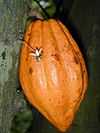Fudge
| Fudge | |
|---|---|
|
Fruit fudge | |
| Type | Confectionery |
| Place of origin | United Kingdom |
| Serving temperature | Room temperature |
| Main ingredients | Sugar, butter, milk |
| Variations | Multiple |
| a 100 gram serving may have over 450 calories kcal | |
|
| |
Fudge is a type of Western confectionery, which is usually soft, sweet, and rich. It is made by mixing sugar, butter, and milk, heating it to the soft-ball stage at 240 °F (116 °C), and then beating the mixture while it cools so that it acquires a smooth, creamy consistency. The product is sold in a variety of flavors. Fruits, nuts, and candies are sometimes added.
Origins
American-style fudge (containing chocolate) is found in a letter written by Emelyn Battersby Hartridge, a student at Vassar College in Poughkeepsie, New York. She wrote that her schoolmate's cousin made fudge in Baltimore, Maryland, in 1886 and sold it for 40 cents a pound. Hartridge obtained the fudge recipe and, in 1888, made 30 lb (14 kg) of fudge for the Vassar College Senior Auction. This Vassar fudge recipe became quite popular at the school for years to come.[1]
Word of this popular confectionery spread to other women's colleges. For example, Wellesley and Smith have their own versions of a fudge recipe dating from the late 19th or early 20th century.[2]

In the late 19th century, shops on Mackinac Island in Michigan began to produce similar products for summer vacationers. Fudge is still produced in some of the original shops on Mackinac Island and the surrounding area. Mackinac Island Fudge ice cream, a vanilla ice cream with chunks of fudge blended in, is also very common in this region and across the United States.
Chemistry
In forming a fondant, it is not easy to keep all vibrations and seed crystals from causing rapid crystallization into large crystals. Consequently, milkfat and corn syrup are often added. Corn syrup contains glucose, fructose (monosaccharides), and maltose (disaccharide). These sugars interact with sucrose molecules. They help prevent premature crystallization by inhibiting sucrose crystal contact. The fat also helps inhibit rapid crystallization. Controlling the crystallization of the supersaturated sugar solution is the key to making smooth fudge. Initiation of crystals before the desired time will result in fudge with fewer, larger sugar grains. The final texture would then have a grainy mouthfeel rather than the smooth texture of high quality fudge.
One of the most important attributes of fudge is its texture. The end-point temperature separates hard caramel from fudge. The higher the peak temperature, the more sugar is dissolved and the more water is evaporated, resulting in a higher sugar-to-water ratio. Before the availability of cheap and accurate thermometers, cooks would use the ice water test, also known as the cold water test, to determine the saturation of the confection. Fudge is made at the "soft ball" stage, which varies by altitude and ambient humidity from 235 °F (113 °C) to 240 °F (116 °C).
Some recipes call for making fudge with prepared marshmallows as the sweetener. This allows the finished confection to use the structure of the marshmallow for support instead of relying on the crystallization of the sucrose.
Hot fudge
Hot fudge in the United States and Canada is usually considered to be a chocolate product often used as a topping for ice cream in a heated form, particularly sundaes and parfaits. It may also occasionally be used as a topping for s'mores. It is a thick, chocolate-flavored syrup (flavored with real or artificial flavorings) similar in flavor and texture to chocolate fudge, except less viscous.
See also
- Toffee
- Condensed milk
- Clotted cream - a probable precursor, with no added sugar, from Devon and Cornwall in England
- Fudge cookie
- Praline - a confection using similar flavors as original fudge
- Scots tablet - Scottish confection with similar recipe
- Krówki - Polish confection similar to fudge
- Penuche - a type of fudge typically found in New England and the Southern United States
- Knäck - a Swedish toffee confection
- Sharbat - a Central Asian dessert similar to fudge
- Barfi - a type of fudge made from cooking milk and sugar into fudge consistency, additions include coconut, carrot, or made from nuts - India.
Notes
References
- Jones, Charlotte Foltz (1991). Mistakes That Worked. Doubleday. ISBN 0-385-26246-9.
External links
| Wikibooks Cookbook has a recipe/module on |
| Wikimedia Commons has media related to Fudge. |
| ||||||||||||||||||||||||||||||||||||

